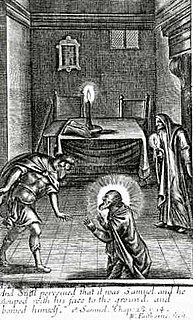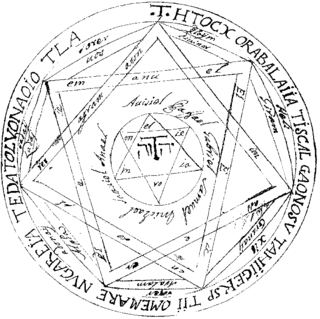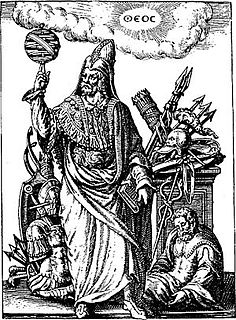Related Research Articles

A grimoire is a textbook of magic, typically including instructions on how to create magical objects like talismans and amulets, how to perform magical spells, charms and divination, and how to summon or invoke supernatural entities such as angels, spirits, deities and demons. In many cases, the books themselves are believed to be imbued with magical powers, although in many cultures, other sacred texts that are not grimoires have been believed to have supernatural properties intrinsically. The only contents found in a grimoire would be information on spells, rituals, the preparation of magical tools, and lists of ingredients and their magical correspondence. In this manner, while all books on magic could be thought of as grimoires, not all magical books should be thought of as grimoires.

Magic is the application of beliefs, rituals or actions employed in the belief that they can subdue or manipulate natural or supernatural beings and forces. It is a category into which have been placed various beliefs and practices sometimes considered separate from both religion and science.

Necromancy is the practice of magic involving communication with the dead – either by summoning their spirits as apparitions, visions or raising them bodily – for the purpose of divination, imparting the means to foretell future events, discover hidden knowledge, to bring someone back from the dead, or to use the dead as a weapon. Sometimes referred to as "Death Magic", the term may also sometimes be used in a more general sense to refer to black magic or witchcraft.

An athame or athamé is a ceremonial blade, generally with a black handle. It is the main ritual implement or magical tool among several used in ceremonial magic traditions, and by other neopagans, witchcraft, as well as satanic traditions. A black-handled knife called an arthame appears in certain versions of the Key of Solomon, a grimoire dating to the Renaissance.
Christian views on magic vary widely among denominations and among individuals. Many Christians actively condemned magic as satanic, holding that it opens the way for demonic possession. Some Christians simply view it as entertainment. Conversely, some branches of esoteric Christianity actively engage in magical practices.
Ceremonial magic encompasses a wide variety of long, elaborate, and complex rituals of magic. The works included are characterized by ceremony and numerous requisite accessories to aid the practitioner. It can be seen as an extension of ritual magic, and in most cases synonymous with it. Popularized by the Hermetic Order of the Golden Dawn, it draws on such schools of philosophical and occult thought as Hermetic Qabalah, Enochian magic, Thelema, and the magic of various grimoires. Ceremonial magic is part of Hermeticism and Western esotericism.
The Lesser Key of Solomon, also known as Clavicula Salomonis Regis or Lemegeton, is an anonymous grimoire on demonology. It was compiled in the mid-17th century, mostly from materials a couple of centuries older. It is divided into five books—the Ars Goetia, Ars Theurgia-Goetia, Ars Paulina, Ars Almadel, and Ars Notoria.

The Key of Solomon is a pseudepigraphical grimoire attributed to King Solomon. It probably dates back to the 14th or 15th century Italian Renaissance. It presents a typical example of Renaissance magic.

The Secretum or Secreta Secretorum, also known as the Sirr al-Asrar, is a pseudo-Aristotelian treatise which purports to be a letter from Aristotle to his student Alexander the Great on an encyclopedic range of topics, including statecraft, ethics, physiognomy, astrology, alchemy, magic, and medicine. The earliest extant editions claim to be based on a 9th-century Arabic translation of a Syriac translation of the lost Greek original. Modern scholarship finds it likely to have been a 10th-century work composed in Arabic. Translated into Latin in the mid-12th century, it was influential among European intellectuals during the High Middle Ages.

Picatrix is the name used today for a 400-page book of magic and astrology originally written in Arabic under the title Ghāyat al-Ḥakīm, which most scholars assume was originally written in the middle of the 11th century, though an argument for composition in the first half of the 10th century has been made. The Arabic title translates as The Aim of the Sage or The Goal of The Wise. The Arabic work was translated into Spanish and then into Latin during the 13th century, at which time it got the Latin title Picatrix. The book's title Picatrix is also sometimes used to refer to the book's author.

The Sixth and Seventh Books of Moses is an 18th- or 19th-century magical text allegedly written by Moses, and passed down as hidden books of the Hebrew Bible. Self-described as "the wonderful arts of the old Hebrews, taken from the Mosaic books of the Kabbalah and the Talmud," it is actually a grimoire, or text of magical incantations and seals, that purports to instruct the reader in the spells used to create some of the miracles portrayed in the Bible as well as to grant other forms of good fortune and good health. The work contains reputed Talmudic magic names, words, and ideograms, some written in Hebrew and some with letters from the Latin alphabet. It contains "Seals" or magical drawings accompanied by instructions intended to help the user perform various tasks, from controlling weather or people to contacting the dead or Biblical religious figures.
In ceremonial magic, banishing refers to one or more rituals intended to remove non-physical influences ranging from spirits to negative influences. Although banishing rituals are often used as components of more complex ceremonies, they can also be performed by themselves.

This is a comparative religion article which outlines the similarities and interactions between Hermeticism and other religions or philosophies.

Hermetic Qabalah is a Western esoteric tradition involving mysticism and the occult. It is the underlying philosophy and framework for magical societies such as the Golden Dawn, Thelemic orders, mystical-religious societies such as the Builders of the Adytum and the Fellowship of the Rosy Cross, and is a precursor to the Neopagan, Wiccan and New Age movements. The Hermetic Qabalah is the basis for Qliphothic Qabala as studied by left hand path orders, such as the Typhonian Order.

In the neopagan religion of Wicca, a range of magical tools are used in ritual practice. Each of these tools has different uses and associations, and not to serve primarily to direct magical energies. They are used at an altar, inside a magic circle.

Renaissance humanism saw a resurgence in hermeticism and Neo-Platonic varieties of ceremonial magic.

An amulet, also known as a good luck charm, is an object believed to confer protection upon its possessor. The word "amulet" comes from the Latin word amuletum, which Pliny's Natural History describes as "an object that protects a person from trouble". Anything can function as an amulet; items commonly so used include gems, statues, coins, drawings, plant parts, animal parts, and written words.

A talisman is any object ascribed with religious or magical powers intended to protect, heal, or harm individuals for whom they are made. Talismans are often portable objects carried on someone in a variety of ways, but can also be installed permanently in architecture. Talismans are closely linked with amulets, fulfilling many of the same roles, but a key difference is in their form and materiality, with talismans often taking the form of objects like clothing, weaponry, or parchment inscribed with magic texts.

A lapidary is a text in verse or prose, often a whole book, that describes the physical properties and virtues of precious and semi-precious stones, that is to say, work on gemology. It was frequently used as a medical textbook since it also comprises practical information about each stone's medical application. Several lapidaries also provide information about countries or regions where some rocks were thought to originate, and others speculate about the natural forces in control of their formation.
The Magical Treatise of Solomon, sometimes known as Hygromanteia or Hygromancy of Solomon, the Solomonikê (Σολομωνική), or even Little Key of the Whole Art of Hygromancy, Found by Several Craftsmen and by the Holy Prophet Solomon, refers to a group of similar late Byzantine-era grimoires purporting to contain Solomon's instructions to his son Rehoboam on various magical techniques and tools to summon and control different spirits, those spirits' powers, astrological beliefs, select charms, different means of divination, and the magical uses of herbs.
References
- Klaasen, Frank. "English Manuscripts of Magic, 1300-1500." in Conjuring Spirits: Texts and Traditions of Medieval Ritual Magic, Claire Fanger, ed. Sutton Publishing Limited: Phoenix Mill. 1998.